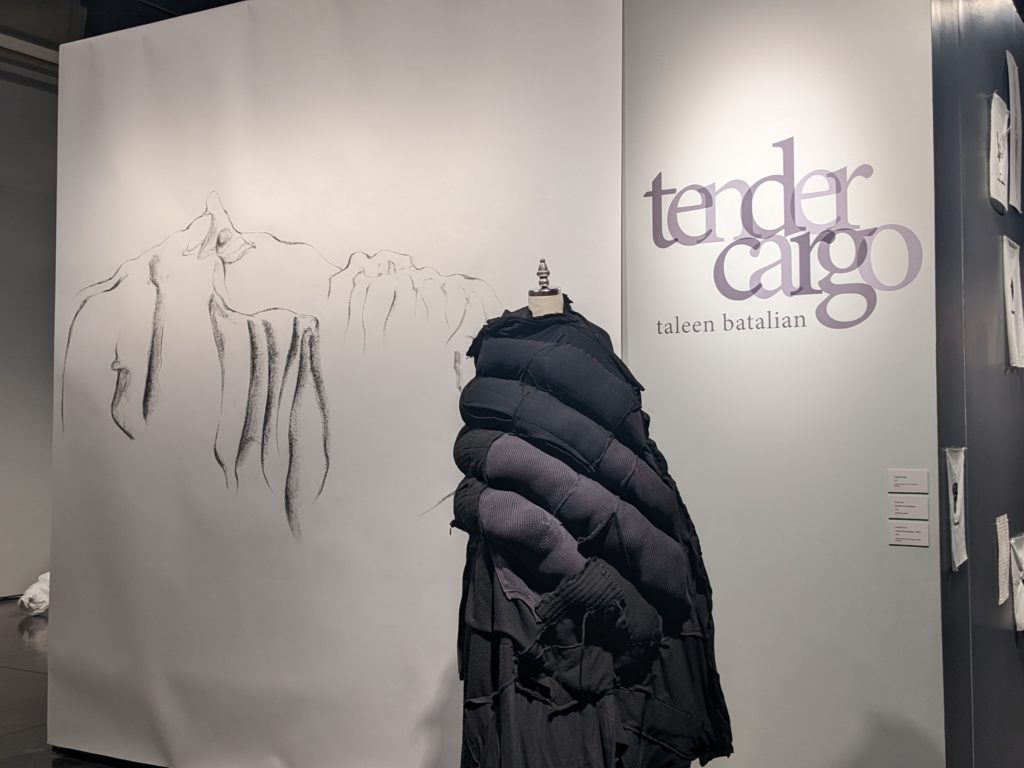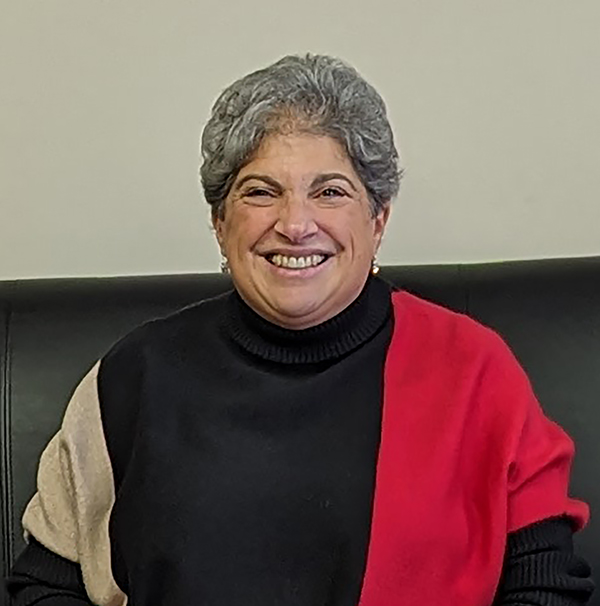
A dramatic black sculptural garment greets the visitor upon entering the newly-opened Tender Cargo exhibit at the WaterFire Arts Center in Providence, RI. The weighty figure hauntingly invites the viewer into the exhibit as the eye travels down the hall to another garment, this time multicolored, facing the entrance, and entitled “Transcendental Garment,” again pulling you into the room and on a journey.

Tender Cargo, which opened on October 13, features the work of Taleen Batalian, a Providence-based artist and educator. Batalian grew up in Watertown, Massachusetts, where she attended St. Stephen’s Armenian Apostolic Church, Saturday school and Sunday school. At Watertown High School, she continued her Armenian language studies with Anahid Yacoubian and served as president of the school’s Armenian club. She is the grandchild of genocide survivors who landed in Lebanon before coming to the United States. Armenian was the primary language in her childhood home, and while there were references to the Genocide all around her, it was never openly discussed amongst the family.

“I always knew that at some point that part of my life would intersect with my art life,” Batalian told the Weekly in an interview several days after the exhibit’s opening reception. Until now, the two had not converged. It was the passing of both her parents – her mother Chenorig in 2012 and her father Khatchadour in 2021 – that got her thinking about her roots.
She recalled an audio recording of her father telling the story of how his parents were orphaned in the Genocide – a recording she had never listened to until then. “Something moved me to think about that recording and to play it so that I could hear his voice while I was working in the studio,” Batalian shared. “It ended up being a turning point because that’s when I started to create the embroideries [in the exhibit] and then the motif of his foot.”
Batalian came to her art through fashion design, receiving her BFA from the Massachusetts College of Art (now Massachusetts College of Art and Design). After several years in the Boston fashion scene with designer David Josef and retailer Lord & Taylor, she became a teacher and built an art program for an elementary and middle private school. Batalian then began exclusively painting for about 10 years, had a stint as director of education for Providence City Arts and finally took the leap to become a full-time artist. This was following her mother’s untimely and tragic death from a brain tumor. It was then that she began working with textiles and fabrics, returning to her roots in fashion, but approaching the artistic creation as she would in painting. Her work at that time was very much about the loss of her mother, which ultimately led to Tender Cargo following her father’s passing.
As one travels through the exhibit, words like “Albatross,” “Reclining Form,” “Complex Terrain,” “Travel Garment” and “Allegory” provide brief explanations of the displayed artwork – pieces that compel the viewer to visit and revisit them from different angles and directions. In addition to the sculptural garments, Batalian’s work includes 2D and 3D artwork. The exhibit is also a collaborative effort with sound designer Antonio Forte, choreographer Heidi Henderson, scenic designer and project consultant Keri King and curator Michele L’Heureux.

At the exhibit opening, Forte told the Weekly that his original soundscape for Tender Cargo was inspired by the recording of Batalian’s father telling his family’s genocide story. The listener cannot discern his actual words, but Batalian explained that the tonality of her father’s voice and how he “would take a deep breath” while speaking, “the moments in between words,” informed Forte’s work as he manipulated and stretched the sound. The resulting soundscape is a strong backdrop for Batalian’s powerful art, masterfully displayed thanks to L’Heureux’s exhibition design and the team’s collaboration.
King also contributed to the exhibit with a graphite drawing on paper called “Gesture of a Mountain.” Batalian encouraged the team to respond to her pieces, to “pursue your own interests and trust that you will find overlaps with your own work and this work.” “No one knew where we would go when we started on this road, and that’s important because that’s what’s going to keep the work alive,” she explained. This process played out with King’s drawing, who told the Weekly that she had been working with mountains and became inspired by those enveloping Geghard Monastery in Armenia. The piece is a meaningful accompaniment to the black Tender Cargo garment as one enters the exhibit, a garment that Batalian said “feels like a shape that conveys and expresses the questions” she grappled with while creating the artforms.

The colors and flow of the gallery take the visitor on a journey that transcends time and space, evoking powerful images and emotions. One garment, white and ethereal with spikes protruding from the upper body, is labeled “Untitled (Protrusions).” A mesmerizing feature of this garment resulted from the layout of the gallery and the airflow, leading to its airy movement and a visceral response from the viewer. When asked about the spikes, Batalian explained that she is not a conceptual artist and works intuitively. Those protrusions began with molding that form with her hands “trusting that the meaning will come through me, through my hands and into the form.”

One wall has works entitled “Lost Places.” For a grandchild of genocide survivors, that wall kept calling for a return. Yozgat, Shabin Karahisar, Belejik (Birecik) and Adana are some of the featured “Lost Places.” Also on this wall are renderings of hands and feet, including “Small Foot with Holes,” all of which speak to the continuing trauma of the Genocide.

Tender Cargo “investigates what it means to wear and carry our pain and asks us to consider how the body traverses under the weight of these heavy loads.” It addresses the questions: “What does it mean to wear one’s trauma?” “How can garments speak to a person’s pain?” and “How does the body traverse under the weight of such garments?” Batalian began working with textiles following her mother’s passing as a means of unpacking the “murky silence” of a genocide unspoken and “to interpret her cultural history to understand the legacy of trauma passed down from her grandparents to her parents and ultimately to her.” “The work is not about the Genocide,” she underscored. “It’s about living with these questions and exploring and investigating these little bits and pieces and how I was able to maybe work through some of those questions with my hands.”
Tender Cargo runs through November 20 at the WaterFire Arts Center. There will be a film screening and discussion on Thursday, November 10 at 6:00 p.m.. On November 17 at 7:00 p.m., there will be a live performance that Batalian described to the Weekly as a “subverted runway” with movement, sculpture and sound, including Forte on the duduk.



Great article. I will try to go see this.
This inspires me to travel to RI and see your exhibit